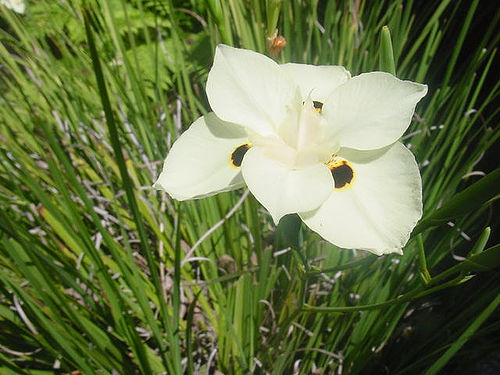Pruning for Fortnight Lily (Dietes iridioides, D. bicolor)
Question from Karen:
I love the flowers of fortnight lily but after many years in the ground mine have grown large. Not only are the clumps huge but some of the leaves have gotten brown and messy-looking with dead foliage and debris mixed in with fresh growth. What is the correct way to prune these plants so they will look good again?

Answer from Pat:
Fortnight lily (Dietes iridioides) is an evergreen, long-lived member of the lily family native to East Africa. Its strap-like leaves grow from rhizomes that creep slowly along the ground to make thick clumps. It is an easy, well-adapted plant for growing in Southern California. Clumps will live for many years and look best with regular irrigation, but can survive with little irrigation once established. Blooms occur in waves at intervals of approximately two weeks, hence the name. To prevent self-seeding in your own garden or your neighbors’ gardens, clip off the green seed capsules after bloom but leave the stems of the white variety on the plant as long as they continue bearing flowers for several years. The stems of the yellow fortnight lilies (D. bicolor) only bloom once, so clip these off after bloom.
Eventually clumps of fornight lily become very thick with growth and the problem is that fresh new leaves mix in with the old spent leaves. It sounds to me as if that has happened with these plants in your garden. After this has happened for several years it’s virtually impossible to clean up a large old clump. One solution is simply to cut off all the foliage now in fall. Cut off the good foliage along with the bad as close to ground level as you can manage. This job can be done with sharp electric hedge shears or even with a very sharp pair of hand held hedge shears. (Some incredibly sharp types of hedge shears are available from purveyors of garden supplies.) But even with the sharpest of hedge shears, this is a difficult job to do because the leaves and flower stems of these plants are notoriously tough and numerous. If you can manage to clip off a clump this way, however, follow up with fertilizer and water, and then let the foliage re-sprout from the ground. Within a short amount of time, the entire clump will renew itself and you will be pleased with the fresh, clean, bright green foliage that will result.
Another way to go, and in my opinion the best option, is to dig up and divide any clumps of dietes that have become overly large and unsightly. The time to do this job is fall or winter. First, water the clump you want to divide. (Plants come up easier out of moist ground.) Then, using a garden fork, dig the clump out of the ground. The roots are not deep, so except for the size of the plants, you will find this job is not too difficult. Once you have the monster out, use a sharp spade to cut it apart into sections. Throw away the old messy center and keep several good divisions. Then using a pair of sharp clippers clean up each new division, cutting away any spent foliage and old woody rhizomes, and keeping the fresh new growth. Amend the soil by digging in a 4-inch layer of fresh compost. Mix a balanced organic fertilizer into the top 6 inches of amended soil applying the correct amount for new plantings given in the package directions, water the bed, let the soil settle overnight and the next day re-plant your new divisions straight back into the ground. You will end up with a whole new planting that will resume flowering in spring and last many years before you once again need to dig up and divide the clumps.



Thank you for your response which is perfect. You have such a succinct way of clearly explaining things.
Thank you..I’m new to this region and have an overgrown yard too play in. Your information was just what I needed!
So glad to be of help! Thanks for writing
Yes, the clumps get big and dense and are hard to damage. I used a chainsaw to cut the dense clump close to the ground. It was, still, slightly difficult.
Thanks for the original idea, though I’m not about to try it. I’ve heard of people tackling bird of paradise with a chain saw but never dietes. What I have heard of is bulldozing. Someone planted a whole front yard of it, the next owner used a skip-loader to get rid of it.
I looked up about 20 sites before I found yours. We have dietes in the small front planter of about 50 homes that have spread into other shrubs in 27 years. Your site was the only one that provided good handling on controlling them. We now know best that we should replace these with another simply trimmed plant.
Thank you. Thank you, for sharing your expansive knowledge. I have you now in my favorites.
Thank you so very much for your very kind comment! Dietes or fortnight lilies flower in waves of bloom throughout the year and can be a very troublesome plant unless one deadheads them properly according to each species so the seeds are not carried around by birds. When yellow fortnight lilies (Dietes bicolor) have finished blooming, cut off the flower stalks down to the ground. They will not bloom again. When white dietes (D. iridioides, D. vegeta) have finshed blooming, remove all the seedpods but leave the stems in place. They will bloom for several years. Otherwise you will find this plant springing up all over and it is a real problem.